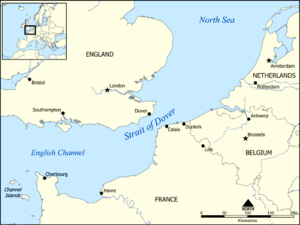Dover Barrage

The Dover Barrage was an underwater blockade of German submarines attempting to use the English Channel during World War I. The barrier consisted of minefields laid between Belgium and Dover at the outbreak of war, followed in February 1915 by steel netting anchored to the sea bed.[1] The first stage of the barrage was completed in April 1915 and it was patrolled by ships of the Dover patrol.[2]
Both sides initially believed the barrier to be effective and the Germans attributed some losses to it. However, in March 1916, the Germans found their submarines could traverse the Channel on the surface at night. The British moved the barrier to cover Folkestone-Cap Gris Nez and used new mines and searchlights, effectively closing the Channel to hostile submarines in August 1918.[1] Underwater scanning of the area covered by the Dover Barrage shows the wreck of SM UB-109 broken in half.[3]
A mine barrage was also used in Dover during the 1940 Siege of Calais.
References
- 1 2 "The Dover Barrage". firstworldwar.com. Retrieved 31 August 2015.
- ↑ "UK Completes Antisubmarine Dover Barrage". Today in World War I. 3 April 2015. Retrieved 31 August 2015.
- ↑ "The Maritime Archaeology of the Dover Barrage". Wessex archaeology on line. Retrieved 1 September 2015.